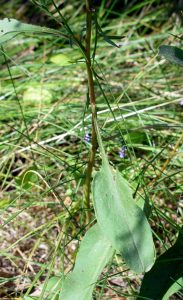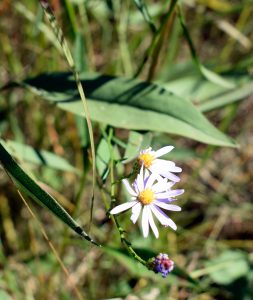Asters with Narrow Leaves
Among the many aster species blooming annually late summer into fall, one of the first ways to narrow down an identification is look at the shape of the leaves. Some very common aster species in the category of having narrow leaves (as opposed to the heart-shaped leaves of many other aster species) are smooth blue, sky blue, New England, and panicled.

Sky-blue aster (Symphyotrichum oolentangiense) has basal leaves that are arrowhead-shaped and/or heart-shaped but in a slim sort of way, and this trait quickly disappears as the leaves ascend the stem, at which point they narrow up considerably and basically disappear. Flowers are only 1//2″ to 3/4″ wide, pale blue to bright blue-violet in color.
 Smooth blue aster (Symphyotrichum laeve) has basal leaves that are somewhat wider, but again, the leaves narrow up as they ascend becoming up to 4″ long and 1.5″ wide, smooth (almost waxy) with the distinctive trait of clasping the stem. Flowers are a bit larger at about 1″ across, light to medium blue or purple-toned (rarely white).
Smooth blue aster (Symphyotrichum laeve) has basal leaves that are somewhat wider, but again, the leaves narrow up as they ascend becoming up to 4″ long and 1.5″ wide, smooth (almost waxy) with the distinctive trait of clasping the stem. Flowers are a bit larger at about 1″ across, light to medium blue or purple-toned (rarely white).
Panicled aster (Symphyotrichum lancelolatum) has consistently narrow leaves at 3/4″ wide and up to 4″ long, and small flowers (like sky-blue aster) at 1/2″ to 3/4″ wide. This flower is the most ubiquitous white flowered aster in Minnesota, and a common sight decorating our shores, woodland edges, meadows, fens, railroads, roadsides, and ditches. This is one reason I chose to give it its own, separate listing! See panicled aster in the section for white flowers.

New England aster (Symphyotrichum novae-angliae) has leaves that are narrow at 1 – 4″ long and up to 1″ wide generally along the entire stem. Flowers are showy, bright, and comparatively large at 1 to 1.5″ across, with rays that are very very narrow — up to 100 of them fill out each bloom. This as opposed, for example, to the much less offering of up to 50 rays seen in the panicled aster, and even less for sky-blue and smooth blue aster species. Thus, in general, the look of New England aster is very distinctive because of these multiple slender petals. The ray color is purple to rose-pink without variation to other colors. I have this flower in my garden, and it absolutely attracts a huge amount of pollinators in the fall. Because of this, and the highly attractive flowers, I strongly recommend adding this plant to your garden landscape if you are looking for a fall bloomer for a space that is in part shade or sun.
